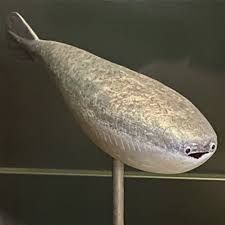How Sacabambaspis Ended Humanity | part 1
874 words • Reading time: 4 minutes
To learn how the Sacabambaspis ended humanity, one must learn how they came to be.
content:
Sacabambaspis are an ancient group of armoured jawless fish in the class Pteraspidomorpha. They are approximately 25 cm in length and are similar in shape to a tadpole. They are particularly notable for their lack of fins, front-facing eyes and plated armour – which no other fish possesses today.
Sacabambaspis are considered the oldest living fossils to survive to the modern day, having first appeared in the fossil record in the Ordivician Period (486 - 443 million years ago). After its rediscovery in the 21st Century, the world was never the same.
To learn how Sacabambaspis ended humanity, one must learn how they came to be.

The Sacabambaspis model at the Natural History Museum of Helsinki, created in tribute to the stuffed specimen at the British Museum.
The Guatavita Fish
Sacabambaspis was first discovered in Lake Guatavita in Colombia. In the 1500s, Spanish and British conquerors temporarily drained the lake in search of gold attributed to the legend of El Dorado. They found a small number of Sacabambaspis inhabiting the lake, and were confused by their peculiar appearance. Despite this discovery, they continuously drained the lake multiple times and doomed this population of Sacabambaspis without further documentation.
Live specimens were brought to Europe, but all attempts at breeding failed due to their harrowingly difficult mode of reproduction. After all individuals died, the animal was quickly forgotten. Records of human encounters with the fish became fragmented and lost. There is a claim that the last Sacabambaspis was cooked and eaten by Queen Elizabeth I, but this is one of the many myths that appeared after Sacabambapis became a worldwide sensation in the 2010s – in reality, all Sacabambaspis that survived the journey to Europe died within days due to starvation and poor living conditions, decades before Queen Elizabeth took the throne.
The last specimen of Sacabambaspis was stuffed and displayed in the British Museum. For centuries, scientists rebuffed this “Guatavita Fish” as a hoax, and those that did believe its authenticity agreed that none could have survived the drainage of Lake Guatavita.
El Dorado is Real, and it is a Fish
The extinct Sacabambaspis janvieri was first described in 1986, based on fossils found near the village of Sacabamba, Bolivia. After further discoveries in the late 1980s and 1990s, striking similarities were noted between the fossil specimens and the Guatavita Fish in the British Museum. This sparked massive controversy and debate within the palaeontology field – was the Guatavita Fish real after all? Lake Guatavita was searched hundreds of times by both professionals and amateurs, during a period known as the “Second Search for El Dorado”. For the next 5 years, the media scrambled to get ahold of any news from Colombia about evidence of Sacabambaspis.
At last, in 2006, a Colombian local discovered a hidden underwater cave in the lake bed of Lake Guatavita, in which a small population of living Sacabambaspis was found. This find rocked both the palaeontological and mainstream worlds: the Guatavita Fish was not a hoax, and its kind had survived the drainage of the lake.
This modern species was named Sacabambaspis eldorado by palaeontologist Alain R.M. Blieck, who spoke on live television the following famous words:
When the Coelocanth was discovered off the coast of South Africa, it was hailed the most remarkable example of a Lazarus taxon. Before its discovery it had been believed to have gone extinct 66 million years ago. This discovery of Sacabambaspis comes 400 million years after its supposed extinction. The fact that a complex organism such as this was able to persist for hundreds of millions of years is an evolutionary marvel beyond reckoning. El Dorado is real, and it is a fish.
Things to Come
Immediately, conservation efforts began to protect the Sacabambaspis. The Colombian government cordoned off the entire lake and global agencies streamed in. Conservation groups across the globe worked ceaselessly to breed the ancient fish. UNESCO labelled the lake a World Heritage Site. The World Wide Fund for Nature temporarily changed its logo from a panda to a Sacabambaspis in celebration of the discovery.
Despite the fantastical miracle of the Sacabambaspis, some expected it would just be another flash fire news story. Before long, the world would turn its head towards the next item of intrigue. The Sacabambaspis would become just another face on the long-running campaign against the extinction crisis and climate change.
But if the discoverers of Sacabambaspis eldorado were to see their future, they would be driven mad with terror. They would all drown themselves in Lake Guatavita, exterminate all Sacabambaspis and end their lineage before it had started. For the Sacabambaspis would have the largest part to play, not only in the affairs of palaeontology, or of the affairs of human society, but of the very fate of the world and all Life itself.
Sacabambaspis would be singular. Their name would be uttered in all song and story, in all language and culture and tradition and religion. They would take to the global stage and fiddle with world politics. They would be cherished as pets, revered as gods and feared as monsters.
And in twenty years, Sacabambaspis would end humanity.
To be continued: part 2

Is this the kind of face that wouldn’t end humanity?